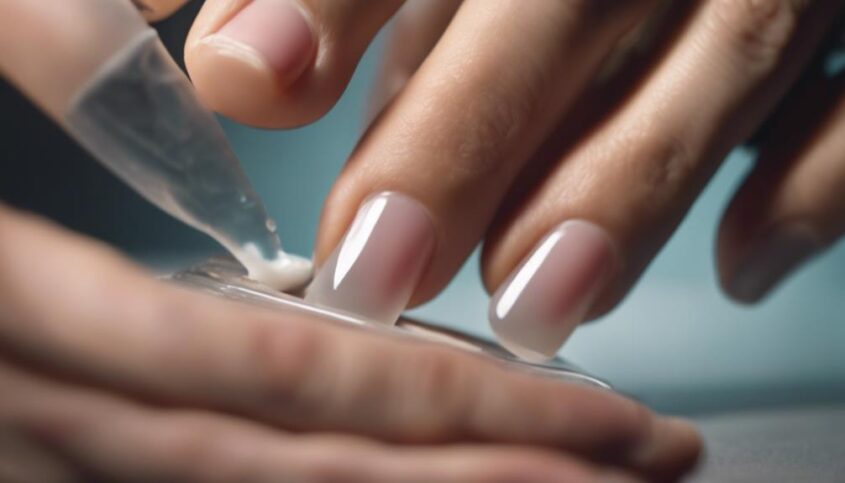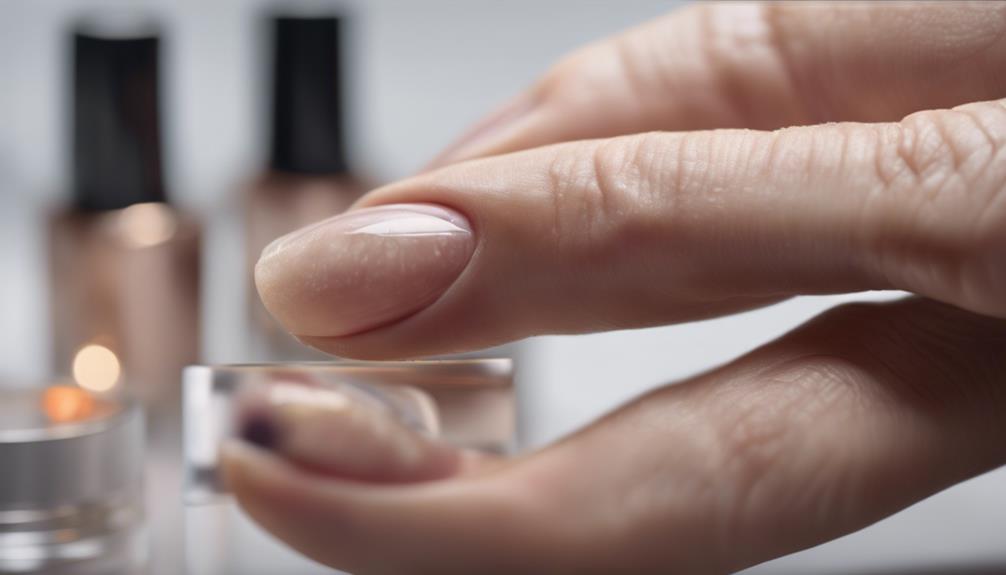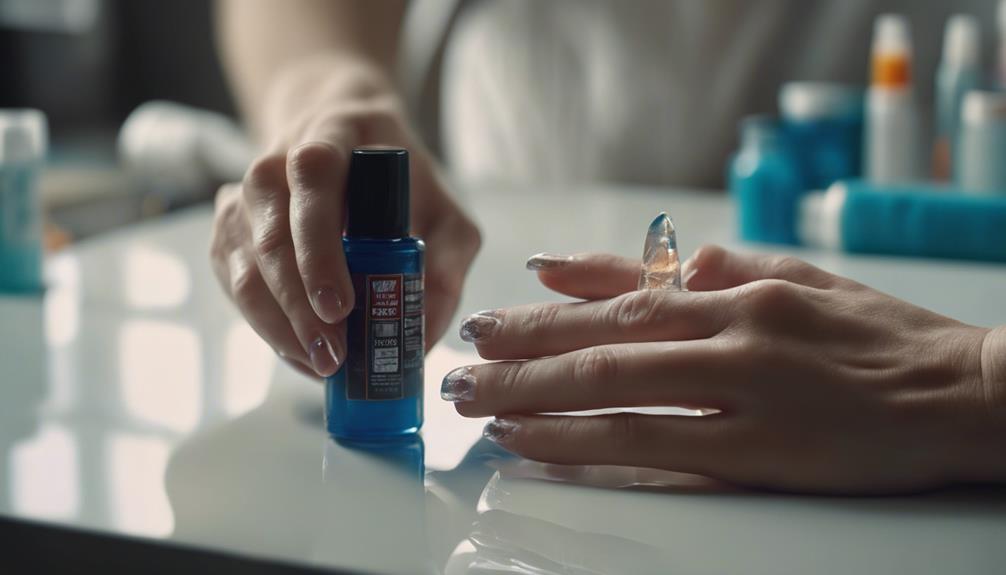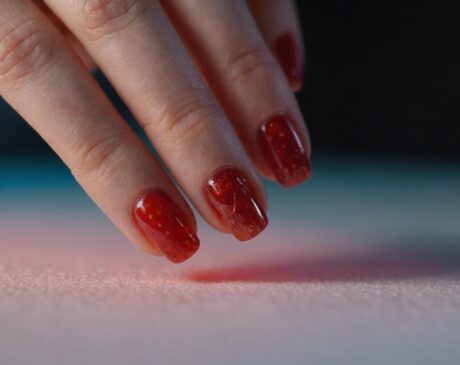Can Base Gel Be Used as Nail Glue?

Base gel can serve as a versatile and durable alternative to nail glue for long-lasting nail enhancements. Its curing process under a UV or LED lamp provides lasting adhesion. The removal of base gel is easier and less damaging to natural nails. Cost-effective due to longer wear, base gel offers reliability and innovation in nail enhancements. For effective application, apply thin, even layers, avoid skin contact, and follow correct curing times. Troubleshooting tips can address any application issues. Base gel strengthens nails, extends wear, and prevents chipping, while nail glue is preferred for artificial tips or extensions. Further insights await on the distinctions between the two nail products.
Key Takeaways
- Base gel can substitute nail glue with proper curing under UV or LED lamps.
- Base gel offers durability and versatility as an alternative to nail glue.
- Base gel is cost-effective over time due to longer wear and easier removal.
- Base gel provides a lasting bond, while nail glue offers temporary fixes.
- Base gel is ideal for gel nail enhancements, while nail glue is used for artificial nails.
Properties of Base Gel and Nail Glue

When comparing the properties of base gel and nail glue, it is essential to understand their distinct characteristics in terms of adhesion strength and durability. Gel application techniques play a significant role in determining the effectiveness of the adhesion between the nail and the product. Base gel, commonly used in gel nail enhancements, relies on curing under a UV or LED lamp to create a strong bond with the natural nail. The application process involves precise layering and curing steps to ensure optimal adhesion strength.
On the other hand, nail glue, often used in artificial nail applications, offers quick adhesion by bonding the artificial nail to the natural nail surface almost instantly. This instant adhesion can be advantageous for some quick-fix scenarios but may lack the long-term durability provided by base gel. Understanding the differences in gel application techniques and adhesion strength between base gel and nail glue is crucial for achieving desired results in nail enhancements.
Understanding Their Key Differences
Base gel and nail glue exhibit distinct differences in their application techniques and adhesion properties, which are essential to grasp for effective nail enhancements.
When it comes to application techniques, nail glue is typically used for quick fixes or temporary nail embellishments. It requires precise application directly onto the natural nail or artificial tips before pressing the enhancement into place.
On the other hand, base gel is commonly utilized in gel nail extensions or overlays. It involves a multi-step process that includes applying the base gel onto the nail plate, curing it under a UV or LED lamp, and then proceeding with the desired nail design.
In terms of longevity comparison, nail glue tends to offer a temporary bond that may last for a few days to a week, depending on various factors such as nail care habits and external activities. Conversely, base gel provides a more durable and long-lasting adhesion, often lasting up to several weeks with proper nail maintenance.
Understanding these key differences is crucial for nail technicians and enthusiasts seeking to achieve professional and enduring nail enhancements.
Can Base Gel Substitute Nail Glue?

Understanding the differences in application techniques and adhesion properties between base gel and nail glue leads to the question of whether base gel can effectively replace nail glue in nail enhancements.
Base gel, known for its versatility and durability, offers a potential alternative to traditional nail glue. When considering application techniques, base gel requires curing under a UV or LED lamp, ensuring a strong bond that can last for weeks. This longevity is a significant advantage over nail glue, which may require more frequent touch-ups.
Additionally, the removal process of base gel is often easier and less damaging to the natural nail compared to nail glue, enhancing the overall health of the nails. While base gel may have a slightly higher initial cost, its cost-effectiveness over time due to longer wear and fewer salon visits makes it a compelling choice for those seeking a reliable and innovative nail enhancement solution.
Tips for Using Base Gel Effectively
For optimal results when using base gel, adhere to the recommended curing times specified by the manufacturer. Proper application techniques can significantly impact the longevity and appearance of your manicure.
Here are some tips to help you use base gel effectively:
- Thin Layers: Apply base gel in thin, even layers to ensure proper curing and adhesion to the natural nail.
- Avoid Skin Contact: Keep the base gel off your skin to prevent lifting and ensure a clean application.
- Proper Curing: Use the correct curing time and ensure each layer is fully cured under the UV/LED lamp to prevent wrinkling or peeling.
Troubleshooting tips can also be beneficial when using base gel. If you experience lifting or chipping, try lightly buffing the nail surface before applying the base gel. Additionally, if the gel appears thick or uneven after curing, check your application technique and ensure each layer is applied thinly and evenly.
Final Verdict: Base Gel Vs. Nail Glue

When comparing base gel and nail glue for nail applications, it is essential to consider their distinct properties and functionalities. Base gel offers several benefits that make it a versatile option for nail enhancements. Base gel acts as a foundation that strengthens the nails, providing a smooth surface for polish application and promoting nail health. It can also extend the wear-time of nail designs and prevent chipping or peeling.
On the other hand, nail glue is specifically designed for bonding artificial tips or nail extensions. Nail glue creates a strong and durable bond that is ideal for attaching artificial nails securely. It dries quickly and provides a long-lasting hold, making it a preferred choice for professional nail technicians.
Frequently Asked Questions
Can Base Gel and Nail Glue Be Used Together for a Stronger Bond?
When combining base gel with nail glue, a stronger bond can be achieved. Understanding the gel vs. glue comparison and applying proper techniques can enhance durability. Utilize innovative methods for optimal results in creating lasting nail enhancements.
Is It Safe to Apply Base Gel or Nail Glue on Top of Each Other?
When considering gel vs. glue application, it is essential to evaluate compatibility with polish. Applying base gel or nail glue on top of each other may compromise the bond and longevity of the nail enhancement, potentially leading to lifting or chipping.
Can Base Gel Be Used to Fix Broken or Chipped Nails?
When considering nail repair, DIY tips often suggest using base gel for fixing broken or chipped nails. This method may provide a temporary solution, utilizing the strengthening benefits of gel polish to reinforce and protect damaged nails.
How Long Does Base Gel Last Compared to Nail Glue?
Base gel offers superior durability compared to nail glue, lasting up to 2-3 weeks. Its application involves a curing process under UV/LED light. In contrast, nail glue longevity varies but typically lasts 1-2 weeks, requiring removal with acetone.
Are There Any Special Removal Techniques for Base Gel Compared to Nail Glue?
When comparing base gel to nail glue, special removal techniques for base gel are essential for maintaining nail health. These techniques may involve gentle soaking or using acetone-based removers to ensure a safe and effective removal process.
Conclusion
In conclusion, base gel and nail glue are two distinct products designed for different purposes. While base gel can provide some adhesion, it is not a substitute for nail glue when it comes to securing artificial nails.
It is important to use each product for its intended purpose to achieve the best results. By understanding the differences between base gel and nail glue, you can ensure that your manicures are long-lasting and beautiful.




